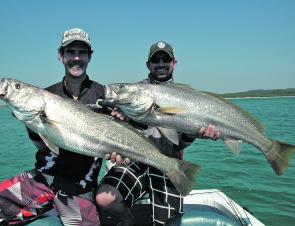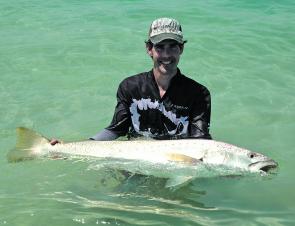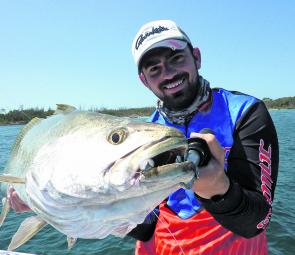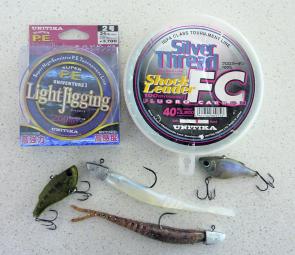South East Queenslanders are spoilt for choice when it comes to productive mulloway locations. These fish can be caught at or near all of the river mouths along the coast, and are a genuine year-round option at Jumpinpin. So with some ideas on what to look for, and a little know-how you could well be landing the fish of a lifetime.
The plethora of winding channels and hidden sand banks that is the Jumpinpin area, lies inside the channel that separates North and South Stradbroke Islands. The area has a range of options for the keen fisho, with shallow weed beds, creek mouths, drop-offs, deep channels, mangrove edges and sand flats aplenty. If you’re after the mighty mulloway though, you’ll want to focus your efforts on the many deep channels, creek mouths and drop-offs the ‘Pin has to offer.
Reading everything I could about mulloway as a kid growing up in Adelaide, the basic info burnt into my brain was that you needed to be the first up, last to bed, fish through awful weather, and always line up your trips with certain moon periods and, most importantly, tide changes. Sure, all of these may work at certain times for certain people, but for me, the equation is far simpler.
Mulloway tend to school up in areas of high tidal flow, nearby to decent structure to help break the flow and allow shelter during the highest flow periods. In the Jumpinpin area, structure is mostly fallen or uprooted trees, and coffee rock ledges. During times of high rainfall, trees that have fallen from the banks move with the flood water and eventually settle somewhere throughout the ’Pin area. If you can find these snags in channels 8m or deeper with decent current flow, chances are mulloway aren’t far away. Add some baitfish to the equation and it’s likely you’re on the money.
Bear in mind after each flood, snags can move so I find favourite mulloway spots are not always the same from year to year. There’s a load of areas like this at the ‘Pin, so sound around and see what you can find.
Once you’ve found your key areas to try, you’ll then need to decide between bait and lures. The majority of my larger fish have come on live baits, but as any lure fisher will tell you, there’s something special about tricking a quality fish like the mulloway on an artificial lure.
In the areas mentioned, during high current flow periods you will need some decent weight in the lure to reach the fish, which usually sit tight on the bottom during the main run of the tide. Generally I will fish jerk minnow style plastics like the Atomic 6” Jerk Minnow in ghost pearl on a 1oz Atomic jighead with 7/0 hook. Each to their own on brands, but whatever you choose, make sure you’re buying quality.
The jigheads I use are built on Gamakatsu hooks, which will withstand the pressure that the mulloway can exert. Buying cheaper gear will leave you disappointed at the end of the day with stories of the ones that got away. My theory is that money spent on gear is only minimal when compared to fuel, rego, boat etc, so don’t skimp on the one bit of gear that gets you, and keeps you, connected to that fish.
Jerk minnow style lures have very little inherent action. For this reason, they will get to the bottom quickly, and once there, you will need to do small subtle flicks of your rod tip to get some action into the lure. Remember your lure will be moving along the bottom with the current; you just need to flick the lure up off the bottom regularly so that it doesn’t get stuck as you drift along.
One of the big keys to successful mulloway fishing with lures is drifting! So often we see guys anchored in huge current, with their baits and lures a kilometre behind the boat, with no chance of being on the bottom. If you drift, you can keep your line vertical, avoiding a huge belly of line that will just catch the current and pull your lure away from where it needs to be. An electric motor will help you position the boat over the lure, but isn’t essential.
A fluorocarbon leader of around 20-30lb and a braid main line of around 20lb will be plenty for this style of fishing. Fish too heavily and your line will catch too much current making your life hard. Unfortunately, the ‘Pin has a lot of sharks, and extended fights can end in your mulloway being eaten, so you need to push your gear to the max to try and get the fish to the surface.
Quality gear will help, but so will luck!
When fishing with bait, I will always use fresh bait. This almost always this means collecting live baits in the morning before trying to find the mulloway. I have found mulloway are not overly concerned about which live baits I use, provided I get them into the right zone with the right rig. So far I’ve caught good numbers of mulloway on yakkas, slimy mackerel, mullet, pike, silver biddies, herring, squid, tailor and whiting.
Generally I look for baits on the larger side, usually around 25cm or above, and fish them on a twin hook rig. My main line is 80lb Unitika Jigging Braid, connected to an 80lb fluorocarbon leader. On this leader I thread a size 6 ball sinker, which can run directly down to my first hook. The hook closest to the sinker will be an 8/0 Gamakatsu Octopus circle hook, and the trailing hook is a standard 7/0 Gamakatsu Octopus. The circle will be hooked up through the top lip or across the nose of the bait, and the trailing hook somewhere down the back of the fish, preferably close to the tail, with the hook point well exposed.
I find the circle tends to hold the bait well, but be sure not to strike when you get a hit. Whenever you use circle hooks, allow the fish to hook themselves and let the rod load up completely before you start to fight the fish. Circle hooks are great for catch and release, as the hook up position is nearly always in the corner of the mouth, leaving the fish healthy to swim off again.
The technique for bait fishing is similar to that of lure fishing, in that drifting will allow you to keep your line vertical, ensuring you are always keeping your bait in the strike zone. Lift your rod tip regularly to avoid snagging the bottom.
Bait fishing allows for heavier line to work, and you will see my gear is far heavier when live baiting. The reason for this is threefold. Firstly, if it works and I can still get the bites, then why not give myself a better chance of landing the fish. Secondly, the fish caught on livies tend to be of a larger size. Finally, sharks are a huge problem at the ‘Pin, so I like to get the fish to the boat as quickly as possible so that they can be released healthily. I hate hearing stories of getting sharked 10 times in a morning. I’d much rather leave the area if sharks are a problem than decimate the mulloway stocks for no good reason.
The above techniques can be deadly on mulloway at the ‘Pin, so please fish responsibly and take only what you need. We are truly blessed to have such a great fishery so close to major cities.
Reads: 5402
Mulloway tend to school up in areas of high tidal flow.

Jumpinpin offers a genuine year-round option for mulloway.

The Pin offers plenty of shallow weed beds, creek mouths, drop-offs, deep channels, mangrove edges and sand flats that a perfect terrain for silver monsters.

The author chasing a fish of a lifetime at the Pin.

A fluorocarbon leader of around 20-30lb and a braid main line of around 20lb will be plenty for drifting mulloway.

The hook closest to the sinker will be an 8/0 Gamakatsu Octopus circle hook, and the trailing hook is a standard 7/0 Gamakatsu Octopus.




